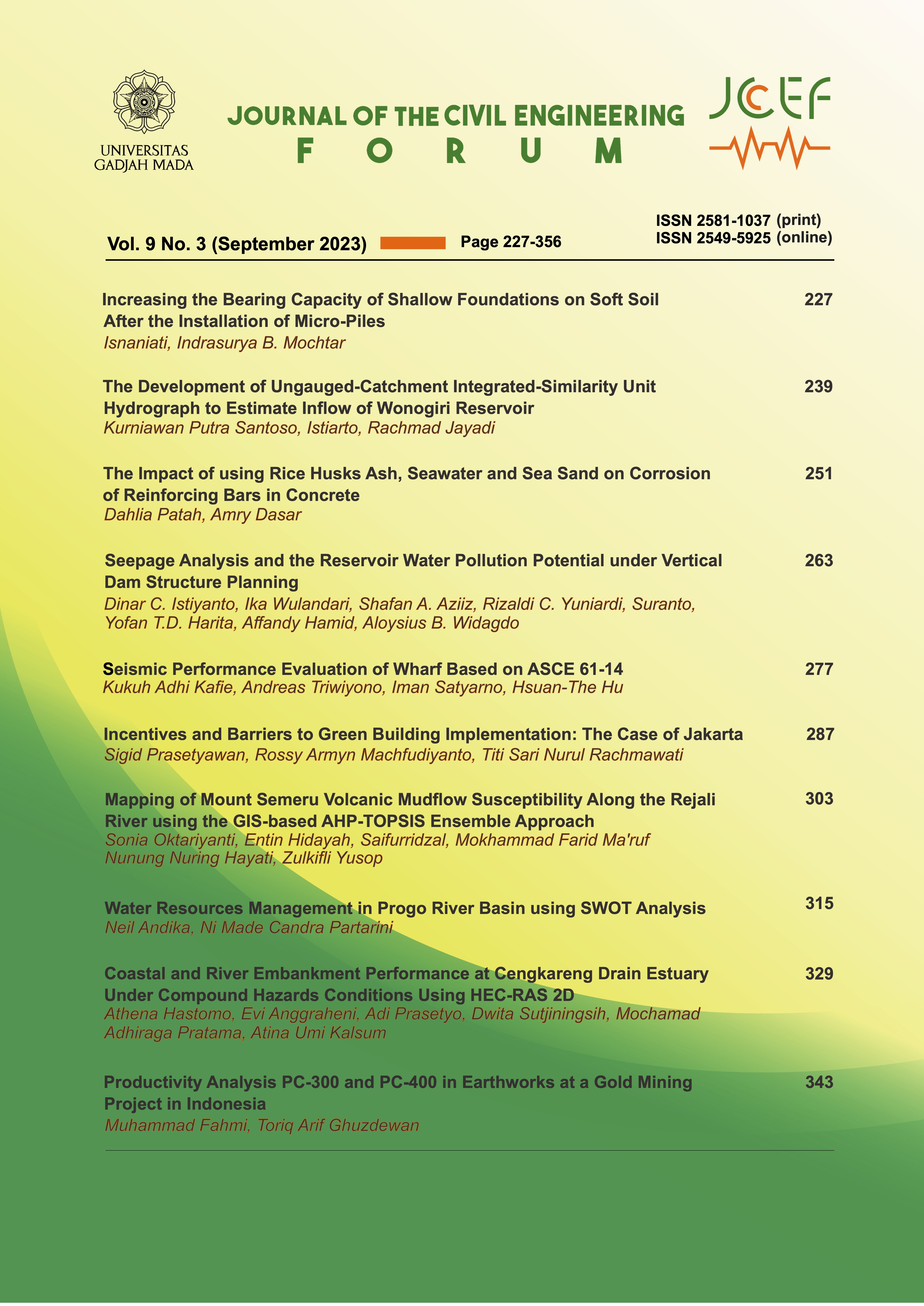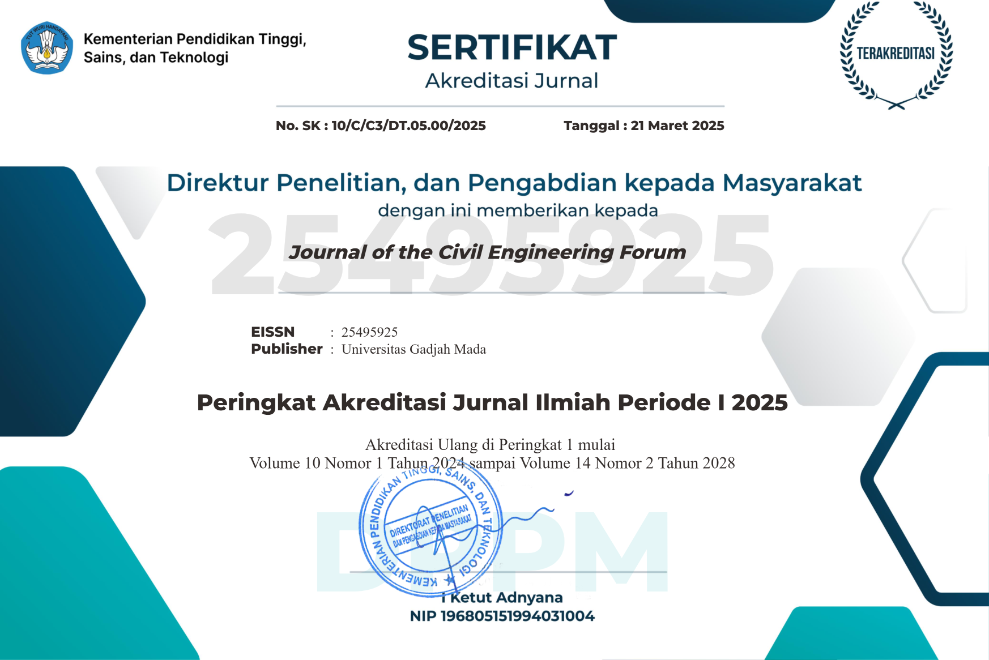Seepage Analysis and the Reservoir Water Pollution Potential under Vertical Dam Structure Planning
Abstract
A prospective resolution to the intricate predicaments of flooding, sanitation, and the availability of unprocessed water for the populace of Jakarta residents is the implementation of the coastal reservoir paradigm. This paradigm entails harnessing the latent capacity of the Cisadane River flow and its subsequent storage within a retention pond, and then subjecting it to reprocessing to serve as a viable source of raw water. The selection of a vertical seawall design was based on the objective of creating an effective barrier between the reservoir and the sea, while also considering several environmental factors. This design was selected with the aim of minimizing the need for extensive soil excavation and rock placement. However, it is important to note that the risks of construction failure associated with seepage under hydraulic structure and dam stability pose significant challenges. Besides preventing saltwater intrusion and maintaining the integrity of the reservoir as a freshwater source, dam must be designed to mitigate potential seepage failure and intrusion issues. To address these concerns, this study employed numerical simulation using the SEEP/W and CTRAN/W software. The simulation was carried out to analyze seepage discharge under a vertical dam and predict potential seawater intrusion into the reservoir. The dam was examined over a ten-year period, with varying embankment widths of 10m, 20m, and 30m. The analysis considered changes in water level (ΔH) and the addition of a cut-off wall at depths of 5m, 10m, and 15m. The obtained results showed that seepage discharge rates amounted to 3,14x10-4 m3 s-1, 2,67x10-4 m3 s-1, and 2,50x10-4 m3 s-1 for embankment widths of 10m, 20m, and 30m, respectively, under a 1m level difference condition. Following this, the safety factor for piping on vertical embankment was determined as 1.10, 1.34, and 1.39 for widths of 10m, 20m, and 30m, respectively. This factor was found to increase to 4.03 when the embankment distance was widened, and a 15m deep cut-off wall was installed. It is important to note that the seawater intrusion model predicted a seawater concentration of 65,12 g m-3 at the bottom for an embankment width of 10m, while no intrusion was observed at widths of 20m and 30m with ΔH=1m. This study aims to assess potential risks of piping due to seepage and seawater contamination at the Cisadane Estuary.
References
Abdoulhalik, A. and Ahmed, A. A. (2017), ‘The effectiveness of cut-off walls to control saltwater intrusion in multilayered coastal aquifers: Experimental and numerical study’, Journal of Environmental Management 199, 62–73.
Abokwiek, R. et al. (2022), ‘A finite element model for the analysis of seepage flow of water under concrete dams’, Geotechnical and Geological Engineering 40, 2823–2841.
Alcaraz, R., Graniel, E., Castro, A. F. and Vadillo, I. (2015), ‘Assessment of groundwater contamination in yucatan peninsula (mexico) by geostatistical analysis’, Environmental Earth Sciences 1.
Alzamily, Z. N. and Abed, B. S. (2022), ‘Experimental and theoretical investigations of seepage reduction through zoned earth dam material with special core’, Material Today 61(3), 998–1005.
Armanuos, A. M. et al. (2022), ‘Impact of inclined double-cutoff walls under hydrolic structures on uplift force, seepage discharge and exit hydrolic gradient’, Ain Shams Engineering Journal 13(1).
Athani, S. S., Shivamanth, Solanki, C. H. and Dodagoudar, G. R. (2015), ‘Seepage and stability analyses of earth dam using finite element method’.
Bappenas (2019), Rencana Pembangunan Jangka Menengah Nasional Tahun 2020 - 2024, Bappenas, Jakarta.
BSN (2017), ‘Sni 8460-2017 persyaratan perencanaan geoteknik’.
Chang, Q. et al. (2019), ‘Effect of subsurface dams on saltwater intrusion and fresh groundwater discharge’, Journal of Hydrology 576(9).
DKI, P. (2021), Laporan akhir data log bor bh-01, bh-02, bh-03, di teluk jakarta, Technical report, Dinas Perindustrian dan Energi Provinsi DKI Jakarta, Jakarta, Indonesia.
Elliotis, M. C. (2019), ‘A mathematical model for a steady-state seepage flow of groundwater under a reinforced concrete dam’, Applied Computing and Geosciences 1.
Fry, J. J. (2016), Lessons on internal erosion in embankment dams from failures and physical models, s.n., Oxford.
GEO-SLOPE (2012a), Contaminant Modeling with CTRAN/W, GEO-SLOPE International Ltd., Canada.
GEO-SLOPE (2012b), Seepage Modeling with SEEP/W, GEO-SLOPE International Ltd., Canada.
Griffiths, D. V. and Fenton, G. A. (1993), ‘Seepage beneath water retaining structures founded on spatially random soil’, Géotechnique 43(4), 577–587.
Jacob, B. et al. (1999), Seawater intrusion in coastal aquifers concepts, methods and practices, in ‘Theory and Applications of Transport in Porous Media’, Springer Science & Business Media, Berlin.
Kasama, K., Zen, K., Nakagawa, Y. and Furukawa, Z. (2020), ‘Instability evaluation of rubble mound for breakwaters subjected to tsunami-induced overflow and seepage flow’, Soils and Foundations 60(6), 1532–1545.
Kementerian PUPR (2017), Modul Analisa Stabilitas Bendungan: Perhitungan Rembesan, Bandung.
Kementerian PUPR (2020), Rencana Strategis Direktorat Jenderal Sumber Daya Air Kementerian 2020-2024, Jakarta.
Klassen, J. and Allen, D. M. (2017), ‘Assessing the risk of saltwater intrusion in coastal aquifers’, Journal of Hydrology 551, 730–745.
Kusuma, A. H. (2019), ‘Sebaran kualitas air pantai utara jakarta pasca reklamasi di perairan teluk jakarta’, Jurnal Teknologi Perikanan dan Kelautan 10, 149–160.
Luyun, R. A. (2010), Effects of Subsurface Physical Barrier and Artificial Recharge on Seawater Intrusion, PhD thesis, United Graduate School of Agricultural Sciences, s.l.
Minardi, S., Hiden, Dahrin, D. and Yusuf, M. (2014), ‘Analisa penurunan airtanah dan amblesan tanah dengan metode gayaberat mikro dan gradien vertikal antar waktu: Studi kasus di jakarta’, Jurnal Ilmu Dasar 15(1), 7–14.
Motevalli, A., Moradi, H. R. and Javadi, S. (2018), ‘A comprehensive evaluation of groundwater vulnerability to saltwater up-coning and sea water intrusion in a coastal aquifer (case study: Ghaemshahr-juybar aquifer)’, Journal of Hydrology 557, 753–773.
Parsaie, A., Haghiabi, A. H., Latif, S. D. and Tripathi, R. P. (2021), ‘Predictive modelling of piezometric head and seepage discharge in earth dam using soft computational models’, Environmental Science and Pollution Research 28, 60842–60856.
Permadi, A. S. C. et al. (2019), ‘Perencanaan pembangunan lepas pantai: Strategi pembangunan berkelanjutan di teluk jakarta melalui pembangunan waduk lepas pantai’.
Purnama, S. and Marfai, M. A. (2012), ‘Saline water intrusion toward groundwater: Issues and its control’, Journal of Natural Resources and Development 02, 25–32.
Qutbudin, I. et al. (2019), ‘Seasonal drought pattern changes due to climate variability: Case study in afghanistan’, MDPI Water 11(5).
Saleh, L. A. (2018), ‘Studying the seepage phenomena under a concrete dam using seep/w and artificial neural network models’, Kerbala, Iraq .
Stocker, T. F. et al. (2014), ‘Working group i contribution to the fifth assessment report of the intergovernmental panel on climate change’, Cambridge University Press .
Tiyasha, Tung, T. M. and Yaseen, Z. M. (2020), ‘A survey on river water quality modelling using artificial intelligence models: 2000–2020’, Journal of
Hydrology 585, 124670. Woo, D. L., Young, J. Y., Weon, M. J. and Dong, S. H. (2019), ‘Experimental and numerical analysis on hydraulic characteristics of coastal aquifers with seawall’, MDPI Water 11(11), 2343.
Zhang, H. et al. (2021), ‘Research on seepage field of concrete dam foundation based on artificial neural network’, Alexandria Engineering Journal 60, 1–14.
Copyright (c) 2023 The Author(s)

This work is licensed under a Creative Commons Attribution-ShareAlike 4.0 International License.
Copyright is granted to authors for the purpose of providing protection for articles written to describe experiments and their results. JCEF will protect and defend the work and reputation of the author and are also willing to address any allegations of violation, plagiarism, fraud, etc. against articles written and published by JCEF. JCEF is published under the terms of the Creative Commons Attribution-ShareAlike 4.0 International License (CC BY-SA 4.0). The author holds the copyright and assigns the journal rights to the first publication (online and print) of the work simultaneously.







